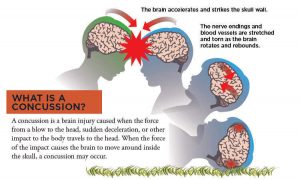Part 1 of 2 on concussion awareness and mitigation for the S&C Professional focuses on defining the injury and its primary root causes, as well as clearing up common misconceptions about the injury. The article focuses in on published research to define prevalence and rate of instance among popular sports.
The term concussion has long been feared, yet largely misunderstood by both athletes and coaches alike. However, as of late, concussion awareness in athletics has been at an all-time high. Increases in clinical diagnoses of the injury as well as research devoted to the cause, effects, and preventative strategies have helped spearhead awareness and thus increased prevention attempts. High profile athletes have begun to step forward into the public eye to raise awareness on concussions and the subsequent consequences that can accompany the injury and, unfortunately, plague their everyday lives. Controversial debate has even taken place in professional sports among league officials and referees to change the rules of the sports where concussions occur at high rates. Sure, concussions have always occurred in the sports that we love, but only recently have they garnered the mass attention necessary to begin the prevention process at all levels. Like any other injury commonly sustained by athletes, it is our job as strength and conditioning professionals to help lead the movement on mitigation and make it a priority in our training.
The first step in creating a program to help our athletes minimize the occurrence of any injury is to better understand the nature of the injury and everything that accompanies it.
What is a concussion and how can it occur?
A concussion is the result of external force being applied upon the body wherein the result of the impact causes a sudden acceleration or deceleration of the head, resulting in a collision between the brain and the skull. Sustaining a concussion can result in severe cognitive, psychological and structural damage to an individual. Common symptoms of the injury include headache, dizziness, nausea, fatigue, and even loss of consciousness. The injury may last days, weeks and in some cases even longer. The severity of the injury is dependent upon many factors. How it was caused, the force of the trauma that occurred, the amount of previous head injuries the individual has sustained, and even the time it took to report the injury to a licensed health care provider are just a sampling of factors that influence the severity of a concussion.

From Children’s Hospital Oakland
Head injuries such as concussions are most commonly thought to occur due to a direct blow to the head via another athlete. These are your big highlight reel hits in football or the massive check into the boards in hockey. This scenario is certainly one of the most common causes of concussion in sport, however it is far from the only one. The direct contact hits by another individual that result in a concussed athlete are easy to recognize because the signs and symptoms of a concussion are usually immediately on display. It has almost become the norm to expect an injury when a vicious hit is sustained during play. However, these types of concussions may partially explain why the injury is so misunderstood. When an athlete displays concussion symptoms to themselves or others, yet cannot trace the symptoms to an event where a large collision took place, they may not actually think they’ve suffered a concussion. This results in athletes failing to report their injury and thus do not get the treatment needed to be placed on a proper rehabilitation protocol.
Other common scenarios where concussions are sustained in athletics may not be as recognizable as the highlight reel hit or direct head contact. Yet these events are every bit as serious, even if though go unrecognized initially. These situations may include when an athlete suffers repeated low-level blows to the head, when an external object (not another human) hits an athlete in the cranial region, or when a player gets wrapped up and their head becomes susceptible to hitting the environment around them, even if at a low velocity. To put into perspective how common these injuries can occur, look no further than specific examples of routine plays that happen in almost any game or match. Instances may be when a soccer player attempts a header and strikes the ball with great force, when a baseball or softball strikes an athlete on the helmet, when a wrestler is taken down and cannot brace themselves before hitting the mat, or a lineman in football colliding against defenders for the duration of a game. The possibilities are numerous. The root cause of concussion can certainly differ, but the injury remains incredibly serious regardless of how it is sustained. Now that the injury and some of its causes are better understood, more effective strides can be made to minimize its prevalence.
Which athletes are at risk?
For many years the primary concern around concussions was based around contact sports, such as football, hockey, rugby and lacrosse, and the high-velocity collisions that accompany them. These contact sports are primarily male-dominated, which meant if you were female or played a non-contact sport you were likely safe from getting a concussion. Even youth athletes that played contact sports were not seen as a high risk of concussion since they could not typically generate the high-velocity impacts that are usually seen at the high school level and above. Those assumptions are actually quite false according to numerous studies on the topic and given the circumstances previously mentioned, it is now better understood that athletes of all ages, both male and female, across all sports, can be at risk of sustaining a concussion in their sport. The goal of bringing awareness to parents and athletes of the potential injuries in sport is not to scare them off and prevent them from playing the games they love, rather it’s to educate with the hopes of increased prevention methods, as well as understanding the proper steps to report and treat an injury if it does indeed occur.
Concussions and youth sports
Research has emerged within the last several years that paints a better picture on the prevalence of concussions in youth and high school sports. The CDC estimates that 20% of the roughly 1.7 million concussions that are reported each year are sports related, with the majority of those stemming from participants in youth and high school sports. It was reported that youth athletes who sustained a concussion from participation in contact/collision sports account for 3-8% of all sports-related injuries reported to the ER (Kelly, et al. 2001). Given the high number of participants in youth sports, those statistics are staggering. For years, concussion instances in youth sports was long an afterthought, yet studies show that young athletes are in fact likely more susceptible to concussions than adults. Concussions represent 8.9% of all high school athletic injuries compared to just 5.8% at the collegiate level (Karlin, 2011, Boden, et al. 2007). Possible explanations for higher percentages of concussion rates in youth athletics include youth and adolescent athletes possessing a larger head to body size ratio, they possess weaker neck muscles, and have an increased injury vulnerability due to the brain still developing (Sim et, al. 2008). To make matters worse, research suggests that children and adolescents take longer to recover than adults (Grady, 2010).
A systematic review and meta-analysis done by Pfister et. Al. examined the incidence of concussions in youth sports. 23 articles were accepted for systematic review (out of 698 considered for review). The accepted research focused on both male and female athletes under the age of 18 and included the following sports as part of the research: football, rugby, hockey, lacrosse, soccer, basketball, baseball, softball, wrestling, field hockey, track, taekwondo, volleyball, and cheerleading. The data compiled from the studies demonstrates concussion prevalence in terms of what the researchers refer to as an athletic exposure, or AE. The researchers define an athletic exposure as “one player participating in any game or practice, regardless of the amount of time spent playing and therefore at risk of sustaining an injury.” In this analysis, the data shows concussion prevalence out of 1000 athletic exposures across the 12 sports. The average incidence of an athlete sustaining a concussion across all identified sports was 0.23 per 1000 athletic exposures. The numbers range drastically dependent upon the sport. Rugby was the highest at 4.18, whereas volleyball the lowest at 0.03. The average incidence of an athlete receiving a concussion may seem low when thought of at 0.23/1000 AE, however when taken into consideration that as of 2011, 30-45 million children, and an additional 7 million high school students participated in athletics, that ratio (.023/1000) is actually incredibly startling. The following chart taken from the systematic review by Pfister et. Al shows the reviewed sports and their rates of concussions in order from highest to lowest, as well as the studies the data was taken from.
The popularity of youth and high school sports are at all-time highs in today’s society. Parents, coaches and athletes alike are constantly vying for any edge in performance they can find. While the constant desire for improving sports and fitness related skills is great for the field of strength and conditioning, it’s imperative that athletes, parents, and coaches allocate time on injuries and preventative methods. Understand that injuries do occur, and will keep occurring, however the better understanding of how and why they occur, the better we can aim to mitigate them. This is especially important in regards to the serious injuries such as concussions where the long term effects are still unfortunately largely unknown.
In Part 2, we will examine some of the preventative measures and how strength & conditioning professionals can assist in protecting athletes from brain injuries.
References
Boden BO, Tacchetti RL, Cantu RC, et al. Catastrophic head injuries in high school and college football players. Am J Sports Med 2007
Grady M. Concussion in the adolescent athlete. Curr Probl Pediatric Health Care 2010;40:154–69.
Karlin AM. Concussion in the pediatric and adolescent population: “different population, different concerns”. PM R 2011;3(Suppl 2):S369–79.
Kelly KD, Lissel HL, Rowe BH, et al. Sport and recreation-related head injuries treated in the emergency department. Clin J Sport Med 2001
Pfister T, Pfister K, Hagel B, et al The incidence of concussion in youth sports: a systematic review and meta-analysis Br J Sports Med 2016;50:292-297.
Sim A, Terryberry-Spohr L, Wilson K. Prolonged recovery of memory functioning after mild traumatic brain injury in adolescent athletes. Neurosurgery 2008

Joe Powell is an Assistant Strength & Conditioning Coach at Utah State University. He formerly held a similar position at Central Michigan University where he also taught classes in the Department of Health and Human Performance. Joe is a regular contributor to the IYCA Insiders program and has been a huge part of bringing the Behind the Science series to the IYCA. He is also the author of the IYCA Guide to Manual Resistance Strength Training. Get more of Joe’s contributions in the IYCA Insiders membership.


